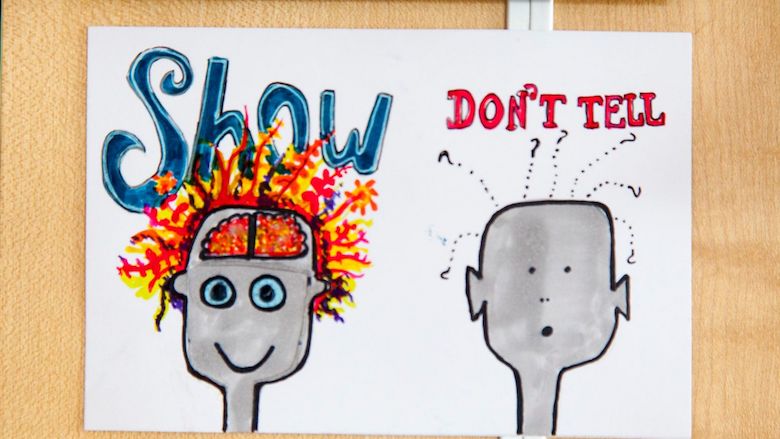How your characters interact and convey information can make or break a novel. If everyone sounds the same or doesn’t use believable dialogue, you run the risk of your reader losing interest, skimming over speech, or putting your book down completely.
Believable dialogue is also a major part of creating believable characters, but sometimes it can be hard to know if your characters sound like real people or cardboard cutouts. How can you be sure you’re getting it right? Read on for four great tips to help you write realistic conversations like a pro.
Show don’t tell

‘Show don’t tell’ is one of the most common tips cited by published authors, and a golden rule for creating believable dialogue. Your reader should be able to determine a lot about your character through their actions, which includes how they speak.
Some writers struggle with this. However, the answer is not to emphasise words using italics, bold typeface, or capitalisation. Instead, describe your character’s surroundings and what they are doing while they speak. It’s rare that people stand still while having conversations, so detail your character’s movements and actions to reflect what they’re thinking and feeling.
This also applies to dialogue tags, although there are two schools of thought when it comes to this topic. Some claim you should only use said to indicate speech because it helps immerse the reader (after a while, they just gloss over the word while still acknowledging who is speaking). Meanwhile, others believe adding the occasional asked, muttered, or yelled adds variety. At the end of the day, it depends on your personal style as a writer. Still, we recommend you try to use said as much as possible and only sprinkle in other dialogue tags sporadically.
Examples:
Instead of: “You need to do it right NOW!” he spat angrily.
Try: “You need to do it right now,” he said, slamming his coffee mug down on the table.
Know your characters

To write believable dialogue, you first need to understand your character and their backstory to determine how they would talk. The way your character speaks and communicates will depend on numerous factors, such as where they grew up, their current environment, and the time setting of your story.
For example, a modern-day teenager from Belfast will speak very differently to a fifteen-year-old in Victorian London.
Do your research to make sure you hit the mark with the distinct historical and geographical mannerisms. However, try to avoid changing the spelling of words or misspelling them as a way to show accents. This is generally considered weak writing and can distract from an otherwise great story.
Examples:
Instead of: “I am ze owner of zis propertee,” the Frenchman said.
Try: “I am the owner of this property,” the Frenchman said in heavily accented English.
Take inspiration from real life

In any given social situation, you will encounter people with incredibly varied ways of communicating. All this can serve as inspiration for penning believable dialogue. Strike up conversations in real life. Talk to people at work, on the bus, or at the gym. Pay attention to how people speak, the kind of language they use, their mannerisms, etc.
Now, apply these real-life scenarios to the characters in your book. Does your character love to ramble on, or speak in short and succinct phrases? Is your character reserved? Outspoken? Do they tend to leave things open to interpretation or over-explain?
Other than just telling readers how your character speaks, these varied forms of communication can also tell us a little about their personality. If you have an easily excitable character, they might be more prone to talk a lot, while a taciturn character would give one-word answers instead.
Something else to note in real-life conversations is that people don’t tend to go off on long rants or monologues. In reality, we’re constantly interrupting each other, and this should be reflected in your writing.
Examples:
Nervous character: “I…like I said, I have an alibi for that night, uh, officer,” he said, picking at a stray thread on the sleeve of his shirt.
Excitable + Taciturn character:
“I saw everything!” she said, bouncing up and down in her chair. “I saw them break into the store and run out carrying all that cash.”
“Really?”
“If I were them, I’d have stolen a few bottles of wine, too.”
“No,” he scoffed.
“I totally would! And not the cheap stuff Rob keeps on the bottom shelf for any old drunk to grab. The expensive wine high up on that shelf in the back.”
Dialogue is a tool

Dialogue is one of the many tools you have to move a story forward. This is why you should be sure that every conversation in your book contributes in some way towards the overall plot. If your characters are just standing around making small talk about the weather, it can slow down the pace and distract from your core story. The occasional piece of small talk is fine if it’s short and tells us something important about the characters, their lives, or the world they inhabit. In general, however, believable dialogue should have conflict to keep it interesting and relevant.
However, it’s also important to remember that your characters should only say what is necessary and what is realistic. Pay special attention to this when you edit your book. Make sure your characters aren’t over-explaining why they made their choices or summarising events and people the other characters would know just for the sake of keeping the reader informed.
For example, don’t write “I had to go to the pub again last night to bring John, my uncle, home” if the other character knows John. Instead, just say “John” or “my uncle”.
The best way to apply this rule is to consider how you would say something. If you, or someone you know, wouldn’t say it in a real-life conversation, then there’s a good chance your characters shouldn’t say it, either.
So, make sure every single conversation counts towards something—whether you’re offering insight into a strained relationship, dropping hints about a mystery, or giving the reader a glimpse of a different culture or place—while ensuring your characters speak like genuine human beings.

